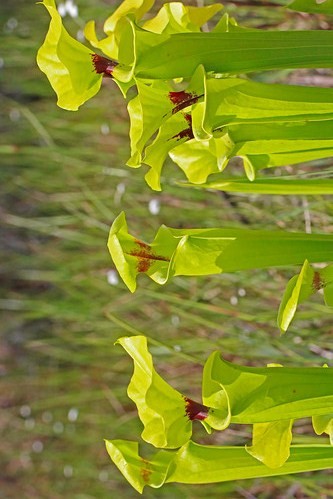"Alabama canebrake pitcherplant "
(Sarracenia rubra alabamensis)

Description
Sarracenia alabamensis, also known as the cane-brake pitcher plant, is a carnivorous plant in the genus Sarracenia. Like all the Sarracenia, it is native to the New World. S. alabamensis subsp. alabamensis is found only in central Alabama, while subsp. wherryi is found in southwestern Alabama, eastern Mississippi and Florida. It is sometimes treated as two subspecies of S. rubra. Like other members of the genus Sarracenia, S. alabamensis traps insects using a rolled leaf, which in this species is finely pubescent and between 20 cm and 65 cm tall. It also forms large clumps within a few years. The uppermost part of the leaf is flared into a lid (the operculum), which prevents excess rain from entering the pitcher and diluting the digestive secretions within. The upper regions of the pitcher are covered in short, stiff, downwards-pointing hairs, which serve to guide insects alighting on the upper portions of the leaf towards the opening of the pitcher tube. The opening of the pitcher tube is retroflexed into a 'nectar roll' or peristome, whose surface is studded with nectar-secreting glands. Prey entering the tube find that their footing is made extremely uncertain by the smooth, waxy secretions found on the surfaces of the upper portion of the tube. Insects losing their footing on this surface plummet to the bottom of the tube, where a combination of digestive fluid, wetting agents and inward-pointing hairs prevent their escape. Some large insects (such as wasps) have been reported to escape from the pitchers on occasion, by chewing their way out through the wall of the tube. Sarracenia alabamensis begins spring by sending up crimson flowers, often several to a growth point. After petal-drop, the first pitchers of the season open. In S. alabamensis, the spring pitchers are weak and floppy, with a large wing. In summer and autumn, larger and more robust pitchers are formed. In subsp. alabamensis, pitchers are yellow-green with reddish veins, whereas in subsp. wherryi, they are shorter and often an olive green color. The plants go dormant in winter, sometimes dying right back to the rhizome in very cold weather.
Taxonomic tree:







